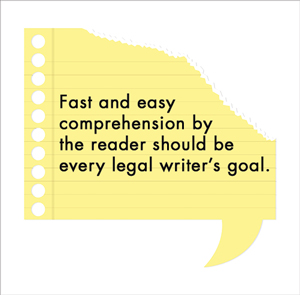To craft an easy-to-understand sentence, make sure the subject, verb, and object do not stray too far from each other.
The subject is the actor in the sentence, while the object is the entity that is acted upon, or the receiver of the action. The object can be a noun, pronoun, phrase, or clause.
To identify the object of a sentence, remember this formula: subject + verb + what or whom? The what or the whom is the object.
For example, in the sentence, “The defendant filed a motion for summary judgment,” defendant is the subject, filed is the verb, and motion for summary judgment is the object.
The reader searches out the subject, the verb, and the object to get the meaning of a sentence.
Legal writing expert Richard Wydick says that “if those three elements are set out in that order, close together, near the front of the sentence,” then the reader will understand the sentence quickly. Fast and easy comprehension by the reader should be every legal writer’s goal.
 Wydick and other advocates for the Plain English approach to legal writing criticize lawyers for forcing their readers to become acrobats. As Wydick has said, “lawyers like to test the agility of their readers by making them leap wide gaps between the subject and the verb and the verb and the object.”
Wydick and other advocates for the Plain English approach to legal writing criticize lawyers for forcing their readers to become acrobats. As Wydick has said, “lawyers like to test the agility of their readers by making them leap wide gaps between the subject and the verb and the verb and the object.”
That is a big mistake that makes for ineffective drafting and poor advocacy. Typically, it results from writing too rapidly and trying to cram too many points into each sentence.
Here’s an example of a sentence where the subject and verb appear too far apart, from Wydick’s Plain English for Lawyers, 5th ed.:
A claim, which in the case of negligent misconduct shall not exceed $500, and in the case of intentional misconduct shall not exceed $1,000, may be filed with the Office of the Administrator by an injured party.
To get from the subject (claim) to the verb (filed), the reader must leap over no fewer than 22 words. To close the gap, Wydick says, turn the intervening words into a separate sentence:
Any injured party may file a claim with the Office of the Administrator. A claim must not exceed $500 for negligent misconduct, or $1,000 for intentional misconduct.
Make sentences with smaller gaps between subject and verb easier to understand by moving the intervening words to the front or the end.
For example, the following sentence, “This agreement, unless revocation has occurred at an earlier date, shall expire on November, 1, 2012” becomes, “Unless revoked sooner, this agreement expires on November 1, 2012.”
The sentence, “The defendant, in addition to having to pay punitive damages, may be liable for plaintiff’s costs and attorney fees” becomes, “The defendant may have to pay plaintiff’s costs and attorney fees in addition to punitive damages.”
Here’s Wydick’s example of a sentence with an unacceptably wide, 21-word gap between the verb (gives) and the object (cause of action): “The proposed statute gives to any person who suffers financial injury by reason of discrimination based on race, religion, sex, or physical handicap a cause of action for treble damages.”
Putting the intervening words at the end closes the gap and improves readability: “The proposed statute gives a cause of action for treble damages to any person who suffers financial injury by reason of discrimination based on race, religion, sex, or physical handicap.”
About the author:
Attorney Savannah Blackwell is a former news reporter who covered government and politics for more than a decade, mostly in San Francisco. She can be reached at savannah.blackwell@gmail.com. Follow her on Twitter at @SavannahBinSF.

